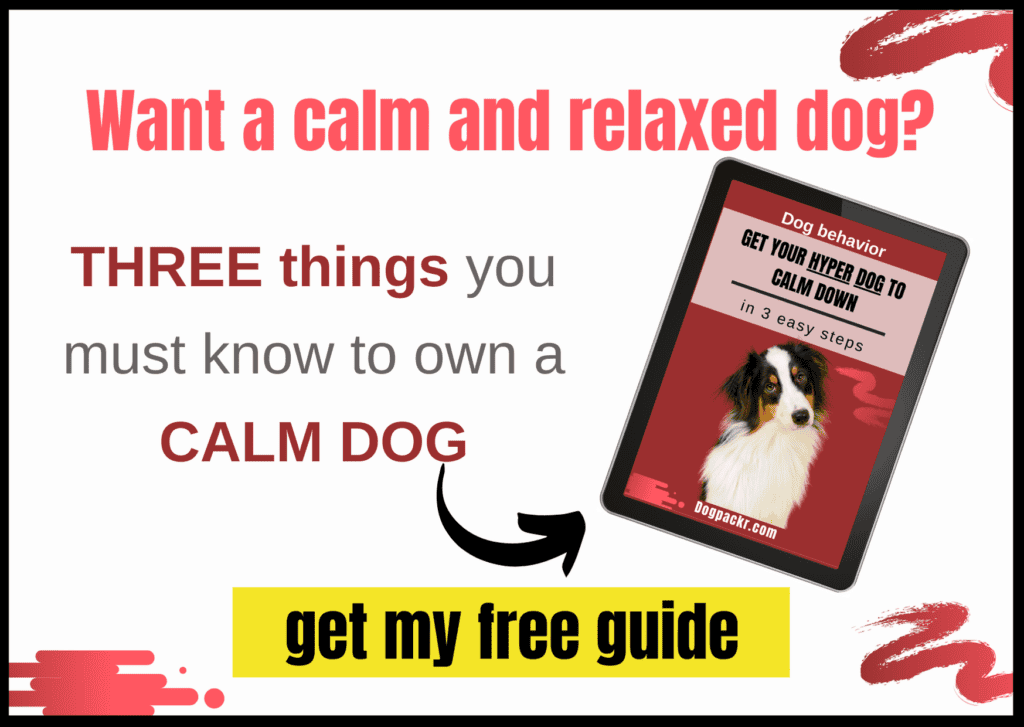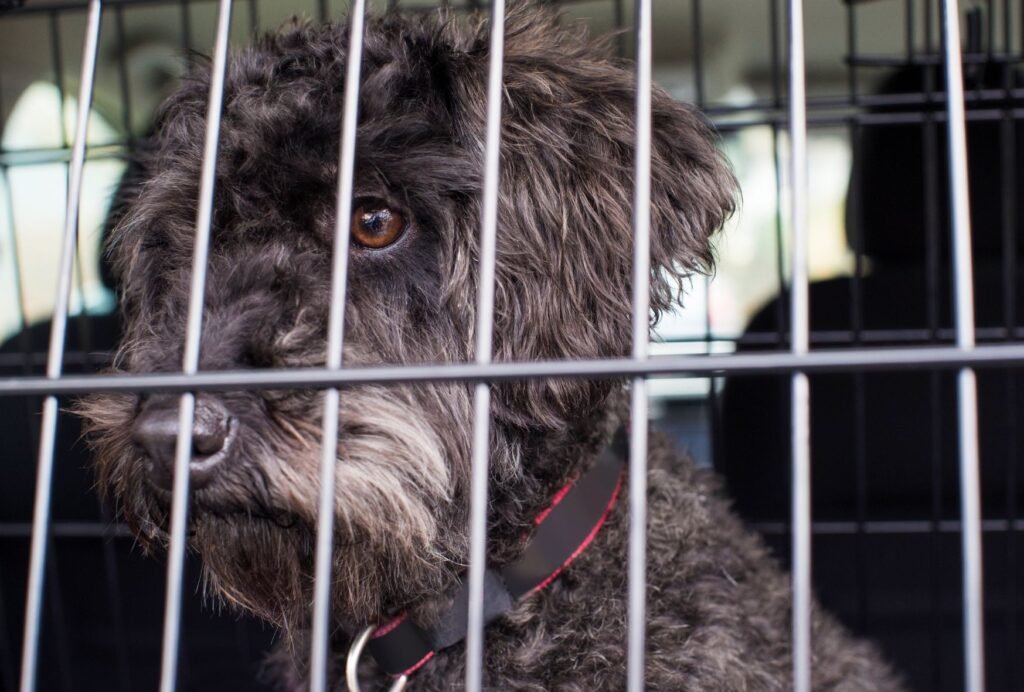
Does your dog suffer from separation anxiety and you’re wondering how you can crate train him?
Well, then you’re in the right place.
My Mini Poodle Baloo used to have extreme separation anxiety. He still has some, but with the right training and routines, it has improved a whole lot!
Crate training definitely helped with the whole process. Dogs with separation anxiety often get destructive because they’re so stressed. That can’t happen in the crate. So, it naturally forces them to calm down.
In order to get there, you need to crate train your dog with separation anxiety the right way, though.
Here’s a quick summary: To crate train a dog with separation anxiety, you need to go very slowly. First, only put up the crate, let him explore it and reward him showing interest. Make sure to always feed his meals inside the crate and give him something to lick or chew. Then, close the door while you’re still in the same room and increase the time very slowly. Once your dog is comfortable leave the room and also increase the time very slowly.
Table of Contents
Does Your Dog Have Separation Anxiety?
Separation anxiety is a complicated and difficult problem to deal with. In short, it means that your dog experiences a lot of anxiety and distress whenever he’s away from you. It might sound cute in theory, but it’s incredibly stressful for you and your dog. Plus, it can even be dangerous!
Crate training your dog is a good way to help him settle down if he’s struggling with separation anxiety. The problem is that putting him in his crate means being separated from you—the opposite of what he wants!
Still, it’s totally possible to crate train a dog with separation anxiety. But before we get into that, let’s go over some of the signs your dog might be struggling with this problem.

Signs of Separation Anxiety in Dogs
With separation anxiety, your dog isn’t just sad to see you go. He’s anxious and scared of being abandoned by you! If your dog has separation anxiety, he’ll show serious signs of distress. This includes panting, whining, pacing, digging, and destructive behavior.
You might come home to your furniture and even walls and baseboard being completely chewed up. There could be scratch marks from your dog trying to escape. If your dog tends to bark or howl when you leave, you’ll also likely have to deal with some pretty unhappy neighbors.
If your dog has separation anxiety, he’ll probably start showing signs even before you leave. Your dog is super intuitive, and can pick up on your “leaving cues”. That means he understands that when you grab your bag or keys, that means you’re about to leave him. And that stresses him out!
For a more in-depth look at separation anxiety, here are 9 signs and symptoms of separation anxiety in dogs.
Should You Crate Train a Dog with Separation Anxiety?
The answer to this question is a little more complicated than a simple yes or no. Every dog is different, and even when searching the question online you’ll probably come up with a lot of different answers.
For some dogs, being left alone in a crate can make them even more anxious. But for many dogs, being in a crate forces them to settle down and relax. It also gives you peace of mind! You know your dog is in his crate and can’t get into anything dangerous while you’re away.
What it really comes down to is how you approach crate training. Working with separation anxiety requires a lot of patience and consistency. As long as you’re willing to provide these things, crate training is a fantastic option to keep you, your dog, and your home safe.
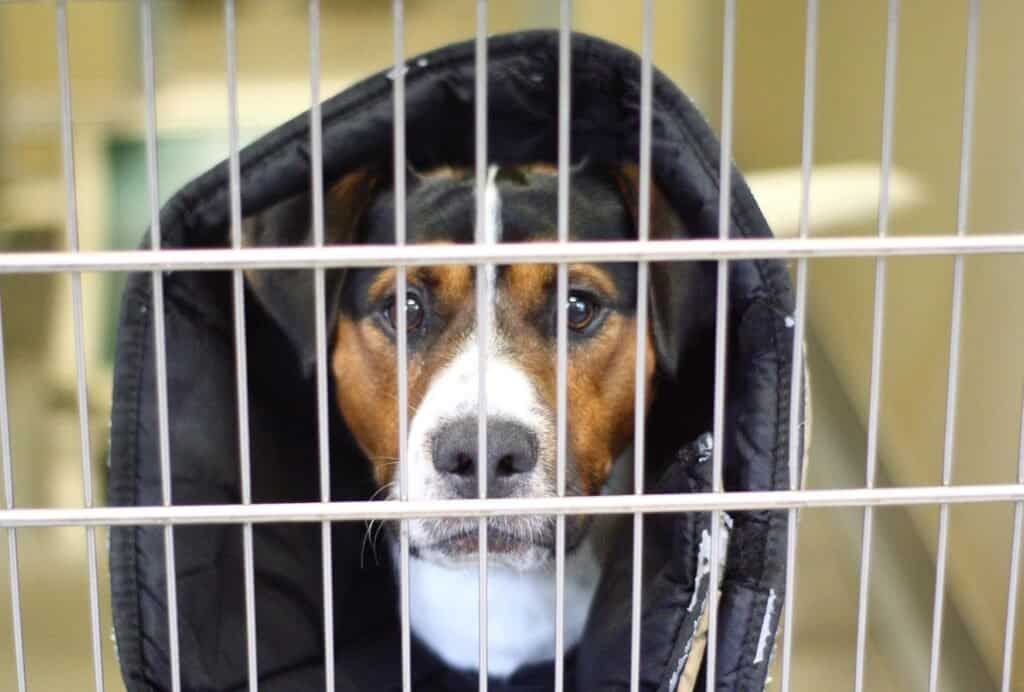
Tips to Help a Dog with Separation Anxiety
Before we get into crate training, here are a few general tips for working with a dog who has separation anxiety.
The first thing is patience and consistency. It will probably take longer for your anxious dog to warm up to the crate, and that’s okay! Just remember to go at your dog’s pace, and watch for signs that you’re going too fast.
You should also make sure to tire your dog out with physical and mental activity before he goes in his crate. This will burn off as much anxious energy as possible, leaving him more relaxed!
Finally, read up on desensitization and counter-conditioning for dogs. This will help your dog get used to your leaving cues, as well as his crate. It will also help your dog stop seeing these as negative things!
Having a set schedule, like I explain in my free guide for a calm dog, also helped tremendously to help Baloo be less anxious.
How to Crate Train a Dog with Separation Anxiety
Now that the time has come to crate train your anxious dog, let’s look at a few key tips and tricks to make him love his crate as his safe den.
For more information, take a look at how to crate train a dog easily in 13 steps. Crate training an anxious dog will follow the same steps, but with a few added parts.
Take It Very Slowly
At first, your dog is probably going to be very wary of the crate. It’s important to go at his pace. He’s already anxious at the thought of you leaving, and forcing him to go into his crate will make those feelings even worse!
Make sure you’ve got a lot of time while you’re crate training, and don’t rush your dog.
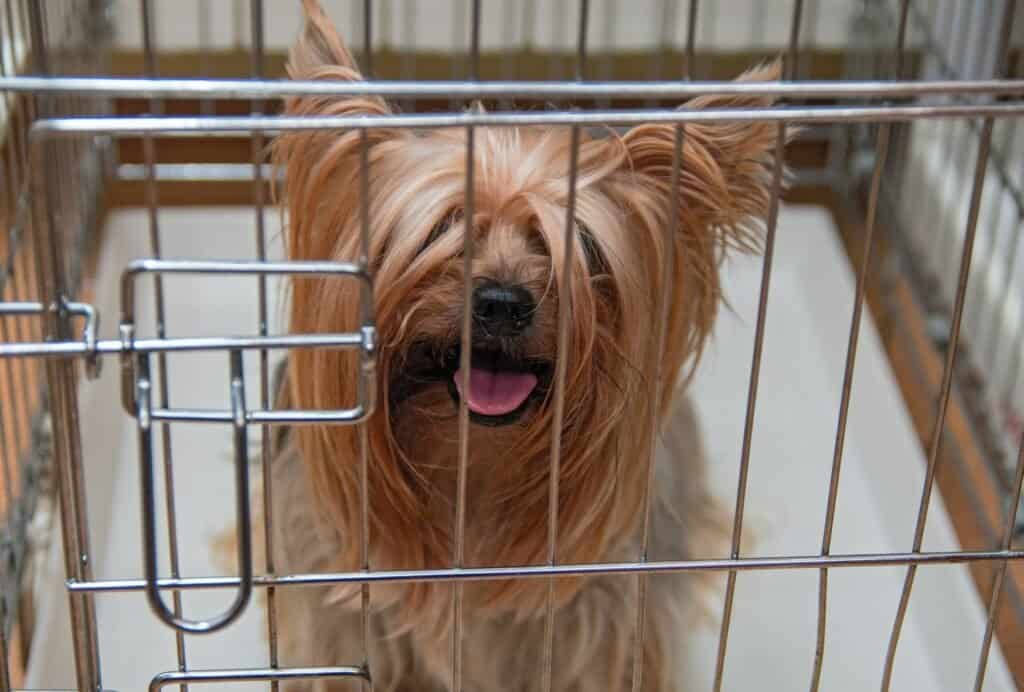
Let Him Explore the Crate and Toss Some Treats Inside
Once you set up your dog’s crate, he’ll probably be pretty curious about it. Some dogs warm up faster to their crates than others, but all dogs will probably want to inspect it.
Make sure to reward your dog if he goes into his crate to check it out. And if he seems nervous about going in, toss a few treats inside! Not only will that get him interested in the crate, it will also get him building positive associations with it.
Feed Him His Meals Only Inside the Crate
Part of crate training your dog is getting him to love his crate. And the best way to do that is making sure amazing things happen in there! All dogs love it when it’s mealtime, so try feeding him his meals inside the crate.
Over time, you’ll watch how excited he gets about heading into his crate!
Give Him Something to Chew or Lick While in the Crate
If there’s one thing dogs know how to do, it’s use their mouths! Dogs explore and experience the world through their mouths from the moment they’re born. Chewing and licking things can be really comforting to your dog. It releases endorphins that make your dog feel good!
Giving him something to chew on or lick is a great way to help your dog settle in his crate. If you want something that will last him a long time, try putting peanut butter and treats in a Kong toy and then freezing it for a few hours or overnight.
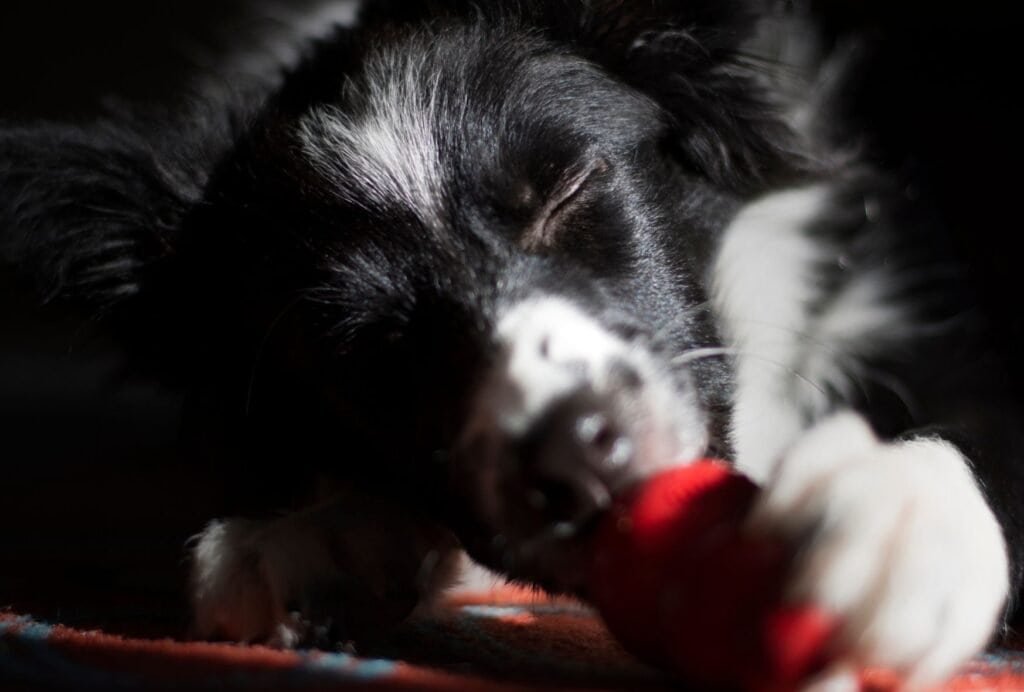
Close the Door for Only One Second at First
Getting your dog into his crate his one thing, but being in there with the door closed is another! This is where going slowly at your dog’s own pace is super important.
Once your dog is comfortable being in his crate, try closing the door. Only shut it for a second, and then open it again. This is just to get your dog used to having the door closed.
Slowly Start to Double the Time the Door Is Closed and Stay in the Same Room
If your dog doesn’t cry or get distressed when you close the door for just a second, then try doubling that time. If he can handle two seconds perfectly fine, then try for 4, then 8, and so on.
Make sure to stay in the same room as your dog for now. We’re working on one thing at a time here, and the first thing we need to do is make sure your dog is comfortable with the door being closed!
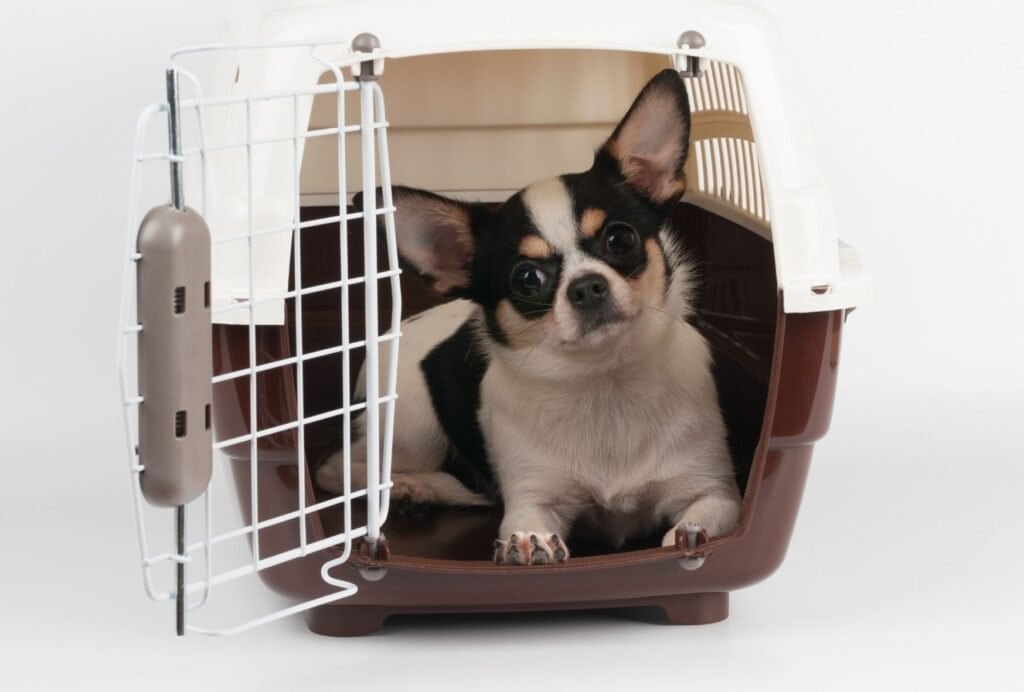
Always Open the Door Before He Starts Crying
One super important part of crate training your dog is that you need to make sure you open the door before he starts crying. If you open it afterwards, this teaches your dog that crying is how he gets out of the crate.
You want to teach the opposite of that! Your dog should understand that to be let out, he needs to be calm and quiet.
Only Leave the Room Once He’s Calm for Several Minutes
Eventually you’re going to want to be able to leave the room—that’s why you’re crate training your dog, after all.
But you also need to remember not to go too fast for your dog. If your dog is able to stay in his crate calmly for several minutes with the door closed, then try leaving the room. Use the same process as before, and leave for one second. If he stays calm, trying leaving for 2, then 4, and so on.
Do Desensitization Training for the “Leaving Cues” While He’s in the Crate
Desensitization training basically means removing the stimulus that is upsetting your dog, and then reintroducing it in a slow and controlled way.
The process can be a little complicated, but it’s also super effective. Here’s a great article about how to use desensitization training!
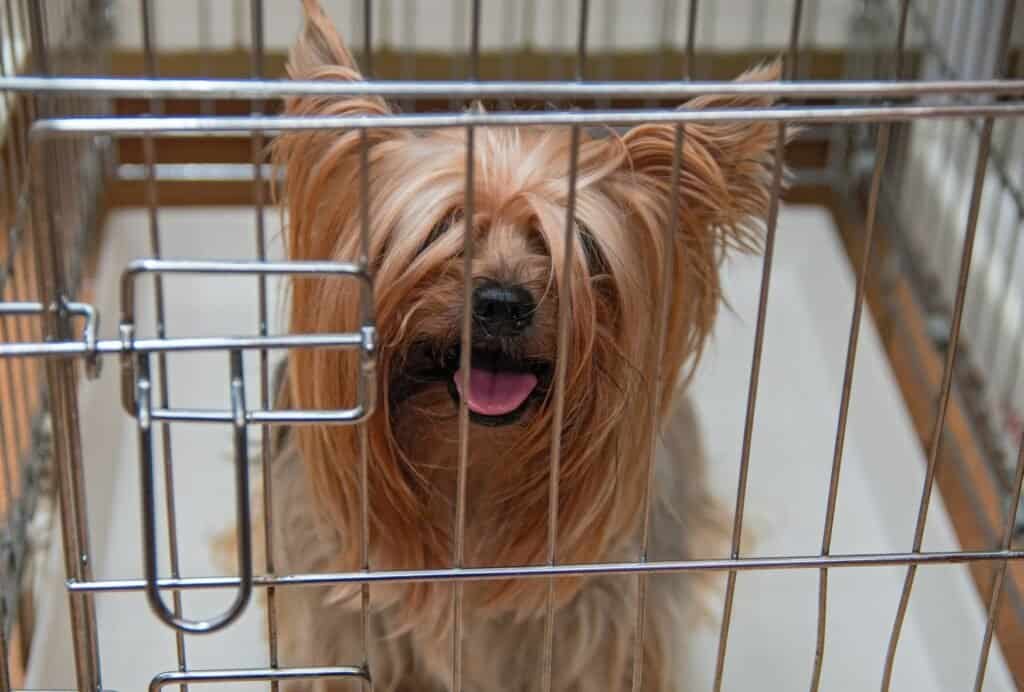
Related Questions
There are a few more related questions I’d like to touch on quickly.
How to Crate Train an Older Dog with Separation Anxiety
If you have an older dog, you might be thinking it’ll be impossible to crate train him, especially if he also has separation anxiety. The good news is that that couldn’t be further from the truth!
If your older dog has separation anxiety, combine the above tips with this article about how to crate train an older dog in 6 steps.
How to Help a Dog with Separation Anxiety at Night
It’s one thing to deal with separation anxiety during the day, and another thing completely to deal with it at night! Being separated at night can be very challenging for both you and your dog, especially since you’re trying to get some sleep.
In general, you should try to make sure you’re tiring your dog out during the day, and that you’re working on crate training consistently. Here’s a great article for a few more tips and tricks.
How Long Can a Crate Trained Dog Be Left Alone?
When it comes to how long a dog can be on their own, it really comes down to the individual dog!
In general, however, your dog shouldn’t spend more than 8 hours in his crate. Less is better, and hiring a dog walker to let your dog out during the day while you’re at work is a great way to make sure he’s not cooped up for too long.
Conclusion
Separation anxiety can be very challenging—for you and your dog! Crate training can help, but the process might be slow and rocky.
Still, as long as you follow the tips above and remember to be patient and go at your dog’s pace, in time he’ll learn to love being in there. Plus, it will help him deal with his anxiety!
*Disclosure: This post may contain affiliate links, meaning, I get a commission if you decide to make a purchase through one of my links, at no cost to you.

